|
Thurs., July 12
1:00 p.m.
ILC ALCPG Physics and Detector R&D Seminar - Hornets' Nest, WH-8XO
Speaker: N. Solomey, Wichita State University
Title: Tagged Neutrons and ILC Calorimeter R&D
2:30 p.m.
Theoretical Physics Seminar - Curia II
Speaker: S. Willenbrock, University of Illinois, Urbana-Champaign
Title: Choosing the Factorization Scale in Perturbative QCD
3:30 p.m.
DIRECTOR'S COFFEE BREAK - 2nd Flr X-Over
THERE WILL BE NO ACCELERATOR PHYSICS AND TECHNOLOGY SEMINAR TODAY
Fri., July 13
3:30 p.m.
DIRECTOR'S COFFEE BREAK - 2nd Flr X-Over
4:00 p.m.
Joint Experimental-Theoretical Physics Seminar - One West
Speaker: A. Sanchez-Hernandez, CINVESTAV-IPN
Title: Measurements of the Λb Lifetime at DZero
8:00 p.m.
Fermilab International Film Society - Auditorium
Tickets: Adults $5
Title: Mùi du du xanh (The Scent of the Green Papaya)
Click here for NALCAL,
a weekly calendar with links to additional information. |
Thursday, July 12
- Southwestern chicken tortilla
- Philly style cheese steak
- *Garlic herb roasted pork
- Tomato basil chicken parmesan
- Southwestern turkey wrap
- Assorted sliced pizza
- *Marinated grilled chicken caesar salads
*Carb Restricted Alternative
Wilson Hall Cafe Menu |
|
Thursday, July 12
Dinner
- Marinated mussels
- Beef & vegetable kebabs
- Rice pilaf
- Lemon cheesecake w/gingersnap crust
Wednesday, July 18
Lunch
- Shrimp & barley salad w/green beans
- Summer melons in spiced white wine
Chez Leon Menu
Call x4598 to make your reservation. |
|
|
Fermilab recycling effort educates and entertains kids
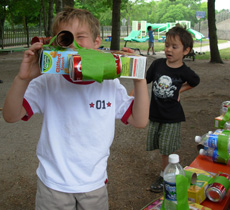
Children in Fermilab's Daycare Center show off art that they created from recyclable material as part of a week-long unit on recycling.
When most people think about recycling, they see blue bins and discarded milk jugs. The children in Fermilab's Daycare Center, however, have a different association: they hear music.
"We had the kids make musical instruments from paper-towel rolls and sculptures with egg-cartons. They got really excited," said Susan Braddy-Suhr, a teacher at the Daycare Center and organizer of a recent week-long unit on recycling.
In her lessons, Suhr emphasized the fun side of waste management by helping the children create artwork out of everyday trash. The students also learned how to correctly sort different items for pick-up. Now, they help with organizing and disposing of recyclables in the new bins that have been placed in each room.
The Daycare Center's effort to educate children on the importance of recycling is a part of the current push to make Fermilab more "green." Suhr's lesson was inspired by the recent arrival of recycling bins in all Village buildings. Receptacles for glass, plastic and aluminum will soon be in place around the site.
Suhr and the other daycare staffers are glad to see the changes. While paper constitutes much of Fermilab's waste-load, the daycare center has a greater variety of garbage. "We shudder to think at how many recyclable items we were tossing to the landfill before," Suhr said. "Now we can dispose of our milk cartons and snack containers properly."
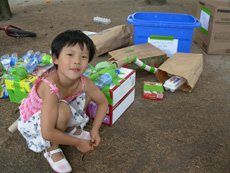
Children in Fermilab's Daycare Center learn to sort different items for recycling.
-- J. Bryan Lowder
|
To bee or not to bee? Bee society and the human condition
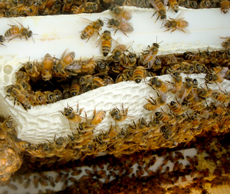
The honey bee's "waggle dance" is the only symbolic language found beyond primates. New genomic data yielded by grid-powered research could help reveal the basis for this and other social interactions.
Stock image from sxc.hu
The humble honey bee: pollinator, producer of honey, and potential key to the secrets of social interaction.
Why can some bees be queen? How can a nurse bee suddenly transform into a forager, just when foragers are needed most? And how can these furry flying insects cast light on our own human behaviors?
Read More
- Cristy Burne, iSGTW
|
Beacon News
July 7, 2007
Valley, make no small plans
By Emily Demar
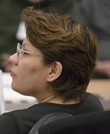 |
| Emily Demar is a member of the ILC Task Force |
... Two activities, both involving events occurring well into the next
decade, have captured my imagination. One is related to Chicago's bid for
the 2016 Olympics. ... The other activity is the development and site for
the International Linear Collider. The ILC will be the world's next
generation particle accelerator, a place to conduct pure scientific
research. Today, the most powerful particle accelerator in the world is
housed at Fermilab, a U.S. Department of Energy National Laboratory located
on the east side of Batavia, along Aurora's northeast boundary.
Fermilab is a magical place of scientific discovery. It also is a source of
jobs and economic benefit for the entire region, as well as an immense
nature reserve. Fermilab's presence in this country helps to assert our
nation's scientific leadership. But, by this time next year, a new particle
accelerator in Switzerland, 10 times more powerful than Fermilab's, will
become operational. Because of the new machine, Fermilab's future is
uncertain. The ILC, which won't be built for another decade, represents an
opportunity to return the leadership in this type of scientific research to
our country, and to our area.
Read more
|
|
|
An illicit interaction
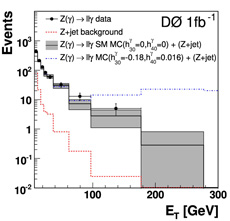
This figure shows the transverse momentum of photons in Z boson + photon events at DZero. The dashed blue line illustrates what would be expected with anomalous Z + photon interactions.
When the particles of our universe interact, they are brought together by one of five mediators: the photon, gluon, and W± and Z bosons. These force carriers of the Standard Model facilitate interactions between matter particles and transmit energy through space. In nearly all cases, the force carriers can also interact with each other. But two of these particles are forbidden to ever meet: the photon and the Z boson. Like Romeo and Juliet, their interactions are not allowed, even though they may share the same stage. And just as with those star-crossed lovers, it might not be safe to trust them to remain apart. However, detecting such an illicit affair is no easy task.
The SM predicts that the photon and Z boson can be produced simultaneously in the Tevatron's proton-antiproton collisions. But they are always separated by a chaperon of a charged quark or lepton. One test for any extra interactions would be to check if the photon and the Z boson are found together more often than what is predicted. If they were, it could be a sign of physics beyond SM expectations. The clearest signatures of Z bosons occur when they decay leptonically to two electrons or muons. By carefully selecting these leptonic Z-boson decays in the company of a photon, physicists at the DZero experiment used one inverse femtobarn of data to measure the rate for Z+photon production. They observed 453 Z→ ee and 515 Z→μμ events with which they measured a production rate of 4.96 ± 0.42 picobarns, which agrees well with the theoretical prediction of 4.74 ± 0.22 picobarns.
After this careful check, DZero scientists proceeded to search for evidence of extra couplings between the photon and Z boson. Theories predict that such couplings would appear as an excess of events at the highest transverse photon energies. By analyzing this energy spectrum, DZero physicists found no evidence for anomalous Z+photon couplings and set limits on possible values. Although it appears the SM's Romeo and Juliet are behaving themselves, DZero will be keeping a vigilant eye out for these illicit interactions.
Read more here
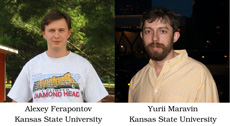
Alexey Ferapontov and Yurii Maravin made primary contributions to this analysis.
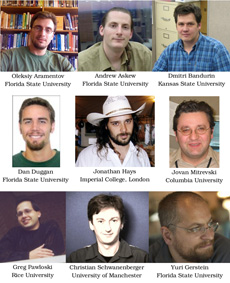
The Electron/Photon Identification group at DZero provides robust tools for reliably identifying electrons and photons.
|
|
Vacancies in DOE Office of Science
The U.S. Department of Energy's Office of Science is seeking a highly qualified candidate with outstanding scientific achievements to fill the position of physicist. Apply here.
International Folk Dance Thursday
International Folk Dancing is being held in Ramsey Auditorium for the summer, at 7:30 p.m. Thursday evenings and will take place on July 12. Newcomers are always welcome, and you don't need to come with a partner. Info at 630-584-0825 or 630-840-8194 or email .
Professional Development classes
New classes are always being added to the professional development schedule. For the most up-to-date course offerings, visit the training web site.
Labwide party on August 3
To celebrate our international community and its achievements, the Fermi Research Alliance will host a labwide party in the Wilson Hall atrium on Friday, August 3, from 3:30 to 6:30 p.m. The theme of the party is "World-class people, world-class research." The party will feature international snacks, beverages, music and door prizes. All Fermilab employees, users, contractors and DOE employees are invited.
|
|